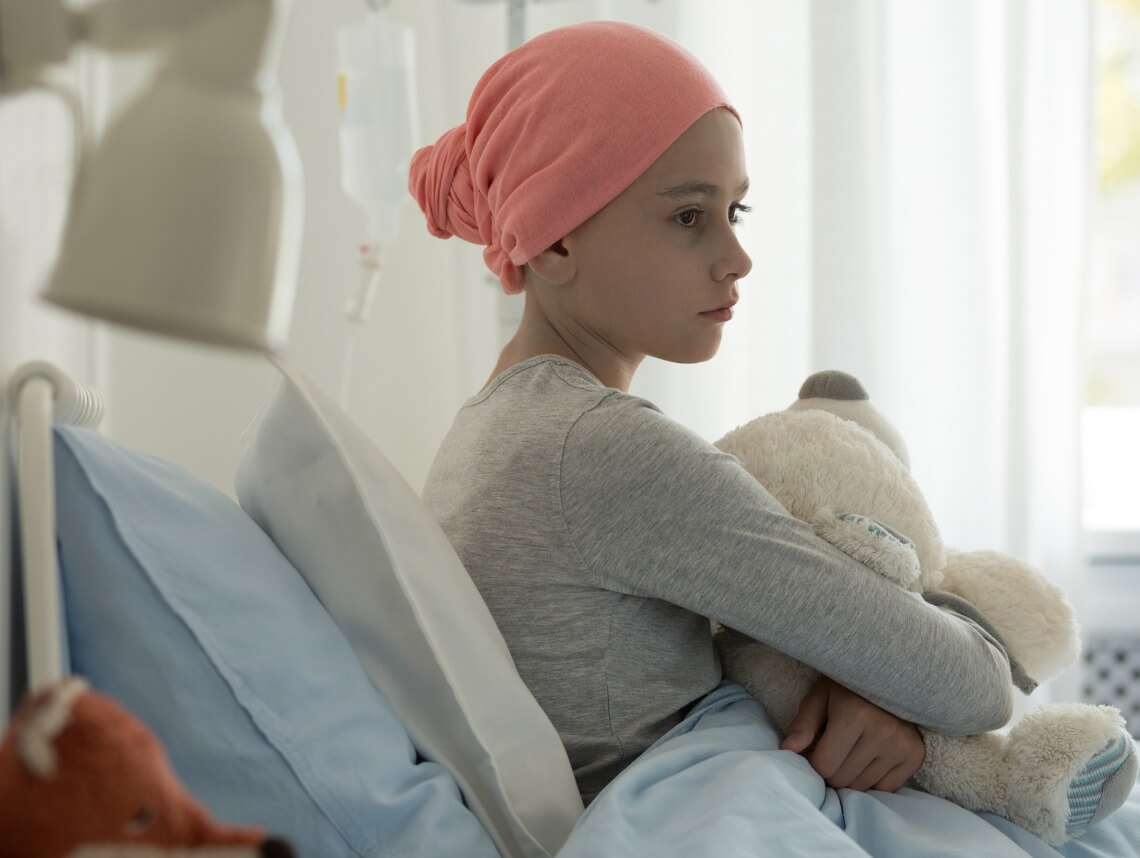When you’re raising a child, there are a few challenges you expect to encounter — sleepless nights, tantrums, and picky diets. But, what you can’t anticipate is a cancer diagnosis. Leukemia impacts more than 3,500 children a year, but it’s difficult to imagine that your child could be one of them. What causes leukemia? How can you spot the symptoms? And, what can you do if your child is diagnosed?
What is leukemia?
Leukemia is one of the most common cancers for children. It causes cancer cells to grow in your child’s bone marrow — which can pass into their bloodstream and travel to other parts of their body. It mostly affects white blood cells, the cells responsible for fighting off infections. The cancer growth forces your child’s bone marrow to make abnormal cells. When this happens, their bone marrow produces fewer healthy cells, and any abnormal cells spread very quickly.
While the cause of leukemia isn’t exactly known, most cases are caused by a gene mutation. This means your child’s chances increase if they have:
- An identical twin who had leukemia at a young age
- A non-identical twin or other siblings with leukemia
- Had radiation therapy or chemotherapy for other types of cancer
- Taken medicines to suppress their immune system after an organ transplant
- A genetic health problem, such as:
- Li-Fraumeni syndrome
- Down syndrome
- Klinefelter syndrome
- Neurofibromatosis
- Ataxia telangiectasia
- Fanconi anemia
Types of Leukemia
The different types of leukemia are classified based on how the condition affects the white blood cells. Most children will either have acute lymphocytic or acute myelogenous leukemia, but other rare types can occur. Some types can also impact red blood cells and platelets. A complete list of the different types includes:
- Acute lymphocytic (lymphoblastic) leukemia (ALL)
- Acute myelogenous (myeloid, myelocytic, non-lymphocytic) leukemia (AML)
- Hybrid or mixed-lineage leukemia
- Chronic myelogenous leukemia (CML)
- Chronic lymphocytic leukemia (CLL)
- Juvenile myelomonocytic leukemia (JMML)
Symptoms of Leukemia
Since leukemia targets the cells that fight off infection, a symptom that your child has this type of cancer is if they get bacterial or viral infections more often than other kids their age. Sometimes, leukemia can also impact red blood cell counts — causing anemia. If this occurs, your child may be pale, feel very tired or weak, and bruise easily or get nosebleeds. But, the most common symptoms of leukemia include:
- Pain in the bones or joints — sometimes causing a limp
- Swollen lymph nodes in the neck, groin, or elsewhere
- Poor appetite and weight loss
- Fever with no other symptoms
- Belly pain
- Chills
- Persistent fatigue, weakness
- Frequent infections
- Easy bleeding or bruising
- Tiny red spots on the skin (petechiae)
- Excessive sweating, especially at night
Diagnosis & Treatment
If you or a pediatrician suspects your child has leukemia, they can conduct a few different tests to confirm the diagnosis. First, a physical exam will be performed, followed by a blood test. Depending on the results, your pediatrician will either conduct a bone marrow test or refer you to an oncologist. An oncologist may want to conduct additional testing, including:
- Bone marrow aspiration or biopsy
- Lab tests of blood and bone marrow samples
- X-rays
- Ultrasound
- Lymph node biopsy
Once diagnosed and the type of leukemia is determined, your pediatric oncologist will begin creating a treatment plan for your child. Most treatment plans will include some form of chemotherapy. The dosage and drug will vary depending on your child’s age and type of leukemia. Additional treatment options will include:
- Radiation therapy – This therapy uses X-ray or high-energy beams to damage leukemia cells and stop their growth.
- Targeted therapy – This therapy focuses on specific abnormalities present within the cancer cells. By blocking these abnormalities, targeted drug treatments can cause cancer cells to die.
- Chemotherapy – This treatment is the major form of treatment for Leukemia. This form of treatment uses chemicals to kill leukemia cells.
- Stem cell transplants – Also known as a bone marrow transplant. This treatment helps reestablish healthy stem cells by replacing unhealthy bone marrow with leukemia-free stem cells that will regenerate healthy bone marrow.
- Immunotherapy – This form uses your immune system to fight cancer. Your body’s disease-fighting immune system may not attack your cancer because the cancer cells produce proteins that help them hide from the immune system cells. Immunotherapy works by interfering with that process.
Caring for a Child With Leukemia
It can be overwhelming to learn that your child is battling cancer — especially if they are young. But, hope is not lost. More than 90% of children with the most common type of leukemia survive. Technology advancements and research about leukemia give oncologists and other specialists the tools and knowledge they need to treat your child effectively. And, there are a few things you can do to care for your child during the process. The most important are:
- Staying positive
- Setting a routine
- Letting your kid be a kid
- Being informed about the condition
- Taking care of yourself
- Establishing a support system
Contact Care Options for Kids for Home Health Care
It can be hard to balance your time between work, home, and caring for a child. That’s why our team of professionals at Care Options for Kids is here to help.
Our home health care services offer support in the comfort of your home. We refer loving and competent nurses to provide customized care for families — from a few hours a day to around-the-clock supervision. Contact us directly to speak with a home health care professional or request a free in-home assessment. Together we can determine the best plan of action to keep your loved ones happy and healthy.
If you or a loved one are considering Pediatric Home Health Care services, contact the caring staff at Care Options for Kids. Call today at (888) 592-5855.






